J.J. CROMER
"For me, every new piece is creating a world, mapping it, and getting myself lost in it, all at the same time."
J.J. Cromer is a self-taught artist and was born in 1967 in Princeton, West Virginia. He grew up in Tazewell, Virginia and except for his and Mary’s years in college, has lived in the southwest corner of Virginia, in the mountains of central Appalachia. A professional librarian, he has worked in public and academic libraries. In addition to many private collections his works are included in the permanent collections of the High Museum of Art, Taubman Museum of Art, Virginia Museum of History & Culture, Intuit: the Center for Intuitive and Outsider Art, the American Visionary Art Museum, and Longwood Center for Visual Arts, among others. His work has been featured in Raw Vision, the New Encyclopedia of Southern Culture (UNC Press).
MEPAINTSME: Your path to becoming an artist is unique. Can you talk a bit about your educational background?
J.J. CROMER: I drew a lot as a kid. My go-to subjects were comic strip characters and Audubon’s birds and animals. An awful 7th-grade art teacher squashed my interest in art, so I got into reading (SF, fantasy, horror, and comics). In college I studied English and history. I didn’t study art. I have masters in English and in librarianship.
MPM: You usually hear stories of that one art teacher who was a huge influence and pushed one towards an interest in art and not the other way around! So you just stopped making art altogether?
JJC: I didn’t make art again for about two decades! Shortly after Mary and I got married in 1998, I started drawing and making collages. The sudden urge to make art blindsided me, I tapped an obsessive vein, and I've maintained a daily practice ever since.
MPM: So your prior career was a librarian! What led you from that to becoming a professional artist?
JJC: Opportunity, luck, doggedness, and frugality.
MPM: Did your parents have any creative interests?

JJC: My father, when he was young, corresponded with comic strip artists: George McManus, Hal Foster, Al Capp, Chester Gould, etc. They sent him letters and art. It was all lost in a flood, except for one small signed piece by Chic Young; I’ve got it in a portfolio. He was also a semi-professional clown. As a child, in full clown kit, I often performed with him (celebratory events sponsored by local civic clubs, private parties, etc.). He was also a cryptographer for the U.S. Department of State in the 1950s. I get my love of asemic writing, codes, nonsense words, neologisms, etc. from him. My mother almost went to Cornell to study ornithology (I was named after JJ Audubon). She is still an active bird watcher. Our son is ten. He’s been accompanying her every year on the Audubon Christmas Bird Count since he was 4 or 5. Both of my parents were secondary school science teachers.
MPM: When I first encountered your work I found it a bit confounding. There is an immediate sense that there are these collaged elements but it’s difficult to track what is collaged or drawn, and somethings feel like they’ve been mechanically printed. Can you talk bit about the materials you use to create your work?
JJC: I work mostly with ink, color pencils, graphite pencils, and collage, on small pieces of paper, usually no larger than 11” x 14”. I use two kinds of collage elements: those I’ve created myself and found sources. The elements I created myself are from finished pieces of mine cut up, as well as new elements created specifically for a given piece. Found sources include things like old photographs, college yearbooks from the 1930s, my childhood stamp collection, and science books for children from the 1960s and 1970s. Until I had a room of my own (a very recent development), I worked at the end of our kitchen table. Nearly every drawing has collage elements; nearly every collage has drawing on it. Very rarely is it exclusively one thing or another, though the ratio varies from piece to piece.
MPM: I would describe your work as abstract, yet there’s actually a tremendous amount of personal iconography and even a bit of narrative. Can you talk about your subject matter?
JJC: For me, nailing down my subject matter is tricky. I can’t but be cagey. Personal history and relationships, as well the news, cultural events, the natural world, things I’m reading or watching, all this informs my subject matter from piece to piece. Ideally, I want whatever emerges on my paper to surprise me; I want it to coax or seduce me into following it into places I don’t expect. I work in series sometimes too; I like to occasionally impose tight, arbitrary rules on myself vis-à-vis a drawing or collage. But even in series work I want to privilege the unexpected; I want to bend the rules as close to breaking as possible. Having said that, reoccurring images do occur for a spell in my work, before disappearing and being replaced with others. Currently, eggs have been showing up — and rabbits, ticks, and snakes.
MPM: Can you take us through the evolution of any particular work?
JJC: Most of my work is directly threaded to previous work. Whenever I’m working on a piece, I have one eye always looking into the possibility of a new piece, unanswered questions, a variation of a mark I feel the need to explore further. If I can leave multiple threads sticking out of a piece to follow at some other point in the future, in a new drawing, that’s even better.
When I’m working on a drawing or collage, I also try to subvert it. I’ll pick out a random collage element, for example, and glue it down in a rudely inconvenient spot. I’ll look away, make a random line or smudge. I’ll force myself to flip the piece, orient it in another direction. All this keeps me from traveling in comfortable ruts. I have a slowly growing personal vocabulary of marks that I return to in each piece, but I’m always trying to change or tweak these marks also. Sometimes, most perversely, if a piece is going really well, I cut it up. My intention is to turn that one piece into cuttings for several new pieces, as in a kind of vegetative propagation.
I have limited skills as an artist -- any structurally-sound bridges I make are accidental -- don’t hire me as an engineer -- but I will do my best to find a way across the chasm. Sitting at my table, with my art supplies, I take comfort and joy in the challenge of living with the infinite number of mistakes I can make.
The quickening of life for a work-in-progress is usually a fuck up.
MPM: Making room for mistakes and allowing them to inherently become part of the work is a a gift in itself! So you don’t spend a lot of time reworking pieces?
JJC: At this point in my life (knock on wood) artmaking has become an autonomic system (I’m still driven to do it), but I can speed things up, slow things down, introduce elements, etc. Generally speaking, I work on a piece until it’s done. I’m often working on more than one piece at the same time. They are often side by side on my table. A current piece often changes dramatically from beginning to end. Sometimes I abandon unfinished pieces and return to them later. Or I leave them abandoned (I have a drawer and several portfolios full of orphaned, half-finished work), or I cut them up (I have many boxes of collage elements). I don’t begin a piece looking for some desired effect or outcome and work towards that. I don’t have the skills or patience to be an illustrator. I’m just making my way through the undergrowth, under the canopy, seeing what I can find. I’m holding hands with the work, but it’s leading me. When a piece is finished, I don’t linger either: “Oh, that’s a good one!” Or: “Ah, that’s a bad one!” For me that’s a trap, a glittery rut.
MPM: I feel your titles serve an important function, allowing the viewer an entry point into your abstract universe. Do they perform the same function for you as the artist? Can you talk about how your titles come about?
JJC: I like titling my work. In my titles I like being reliable and unreliable; it varies from piece to piece. I make titles up, or I steal them from something I’m reading or watching, or I might steal something and then tweak it.
MPM: You’re a self taught artist and have become recognized as part of what might be considered ‘visionary’ or ‘outsider’. Do you see yourself and your art distinct from the contemporary art world?
JJC: No? I don’t know. It’s not really something I think about. If I have to qualify my identity as an artist, I do use “self-taught.” I don’t know how valid these distinctions are anymore though. In recent years the taxonomic requirements for entry into the Outsider Art Fair have become less restrictive. The gate used to be very strait. This liberality, I think, has trickled into the curatorial decisions of “outsider” galleries as well. A similar openness, I believe, is happening on the “insider” art market. I have seen more and more interest in my work from outside of the specialized folk/self-taught/outsider collector. I’m grateful for this. I’m also very grateful for all the doors my “outsider” galleries have opened for me.
Besides lacking an MFA, I think I am in one way distinct from the contemporary art world, making me stereotypically an “outsider.” My existence is decidedly and deeply rural. We live in a very red part of southwest Virginia. From what I can tell in my particular social media bubble, I’m probably more geographically isolated than the majority of artists I follow or who follow me. I see many images of openings, studio visits, group photographs, general hobnobbing, and affectionate backslapping, etc. The circumstances of our family life restrict the number and length of trips we can take. I can’t knock on doors, we miss 99.9% of openings, but I can send emails and make calls; I can press my thumb upwards and spread hearts liberally. We really value museums when we’re able to travel. I try not to let our isolation bother me. I just do my work. (We do appreciate visitors!) And I’m also very grateful for my work’s representation by others closer to where art things are more densely packed and attended.
MPM: In addition to being an artist you also have a passion for collecting art which has resulted in an unbelievable collection! Can you tell us a bit about what led you to collecting art?
JJC: Thank you. I love trading work. Much of our collection was traded. I’ve traded with lots of different folks. I once traded with a professional chef. Every month for a year he sent us spectacular care packages. Another time I traded with a well-known musician. He sent me a box of band swag, tees, albums . . . And when we can, if the household budget allows, we also buy work. I’ve always believed in greasing the karmic wheel regarding my presence in the art market: when my work is bought, if we can, I want to buy someone else’s work. We don’t have a lot of friends locally, so we really appreciate the friendships we’ve made through art. We hope to travel more and meet them IRL. We’ve met some. If someone feels like making the trip here and hiding out for a spell, we do have space for guests. I won’t publish your presence on social media; I’d ask you to do likewise. DM me! Mary is gluten free and can’t eat dairy or corn. But I’m a pushover for baked goods. If you see me in the corner doing something furtive, I’m probably eating that loaf of bread you had in the back seat of your rental car.
MPM: What are some of your personal favorites from your collection?
We love pieces from friends and acquaintances particularly: Lou Beach, Michael Noland, Tony Fitzpatrick, Domenico Zindato, John Dilg, Robert Pokorny, Neil Farber, JJ Manford, Margot, Michael McGrath, Gerard Cambon, Amber Groome, Mehrdad Rashidi, Marilena Pelosi, Sylvain Corentin, Bill Fields, many others. I love a trade.
MPM: If you had to articulate your approach to making art what would say is your personal philosophy?
JJC: I like that making art is a daily way of looking at the world by mucking about in my psyche. Art slows me down, tricks the light, throws voices, raps on tables. As a child I was adept at getting lost and seeing new things (real and imaginary) in very small, fenced spaces. My yard easily became infinitely large and mysterious (the sky above me was also an imaginal space). I try to approach art in the same way. For me, every new piece is creating a world, mapping it, and getting myself lost in it, all at the same time. I can probably take you exactly where you want to go in a library. In my artwork I’m not all that interested in clearly marking your path. (For years I would have aural hallucinations while doing my work.)
Discovering what’s around the corner is a big part of my drive to make new work. I like surprises and ambiguity. I like color. I like the accidental smears of glue that dirty up during the making of a piece. I like circles more than squares.
Preview a selection of artworks that will be featured in the forthcoming solo exhibition at MEPAINTSME Gallery:


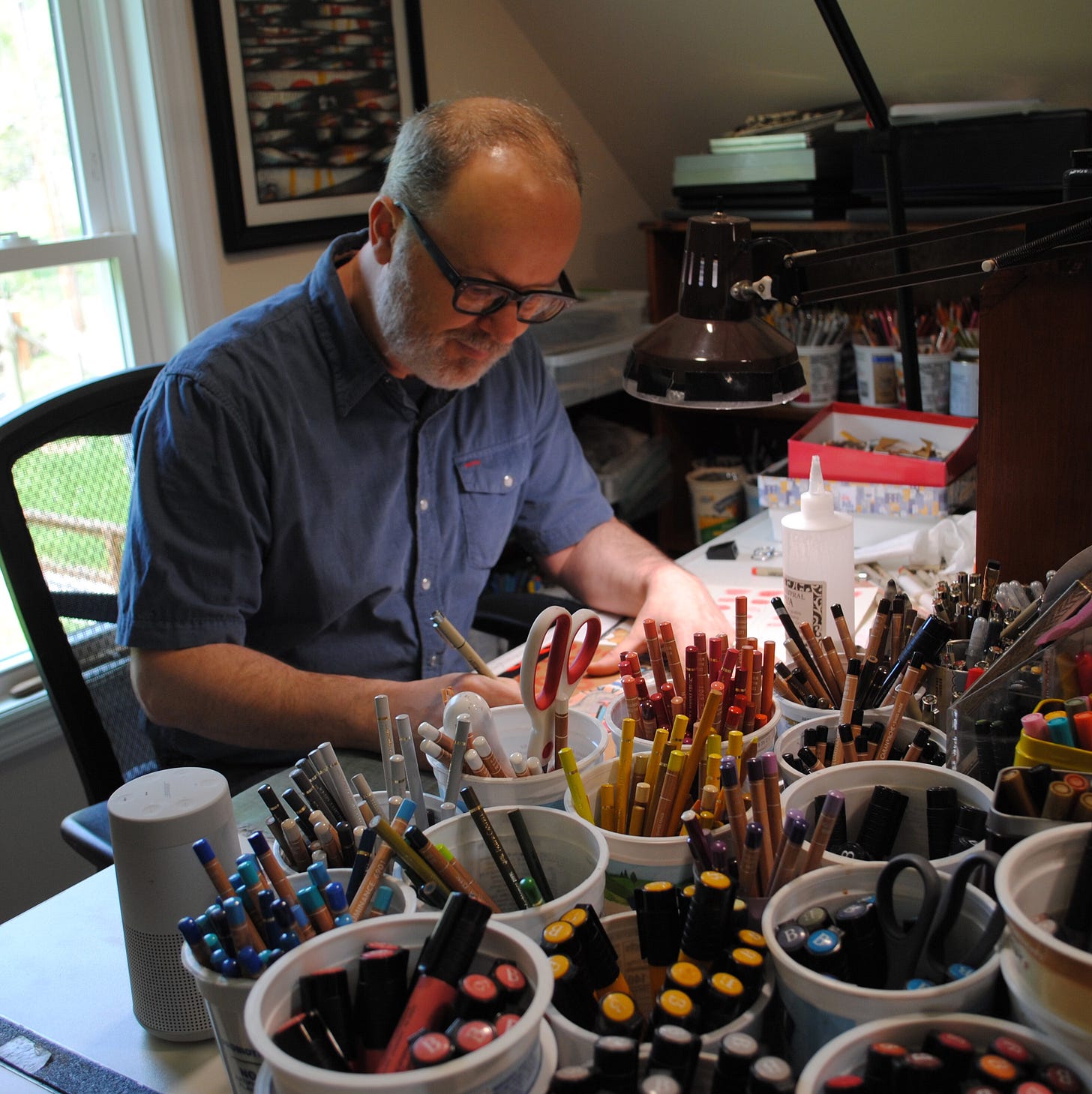

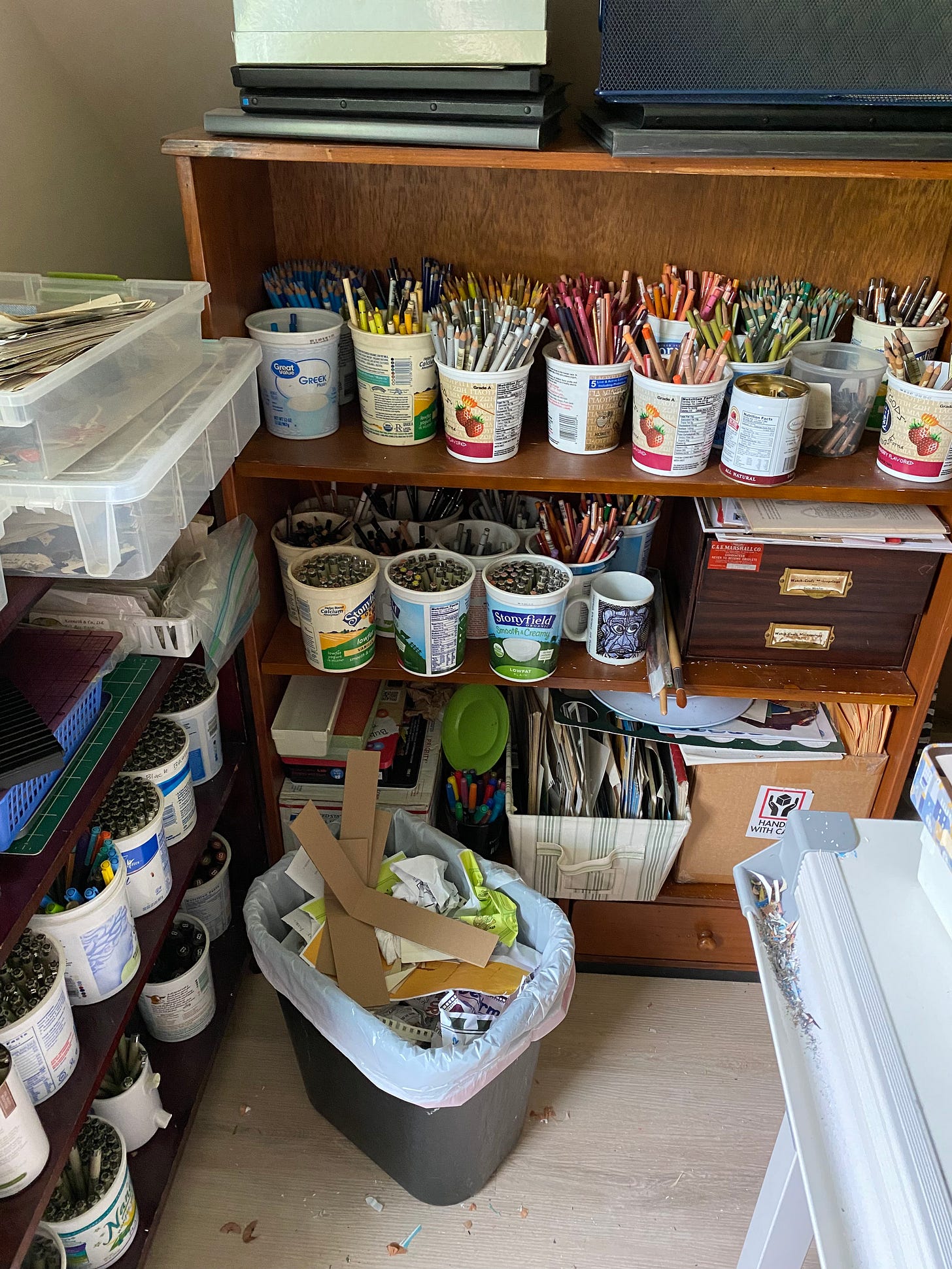
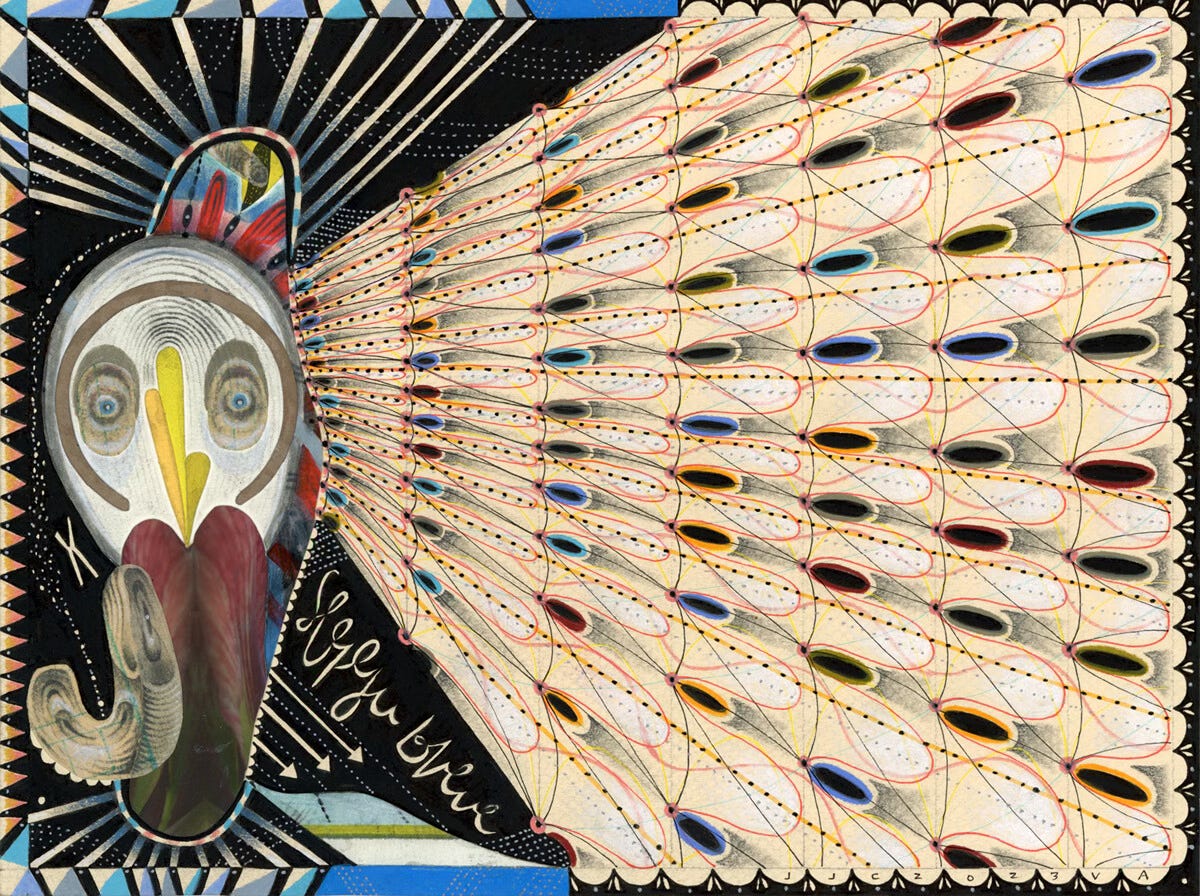
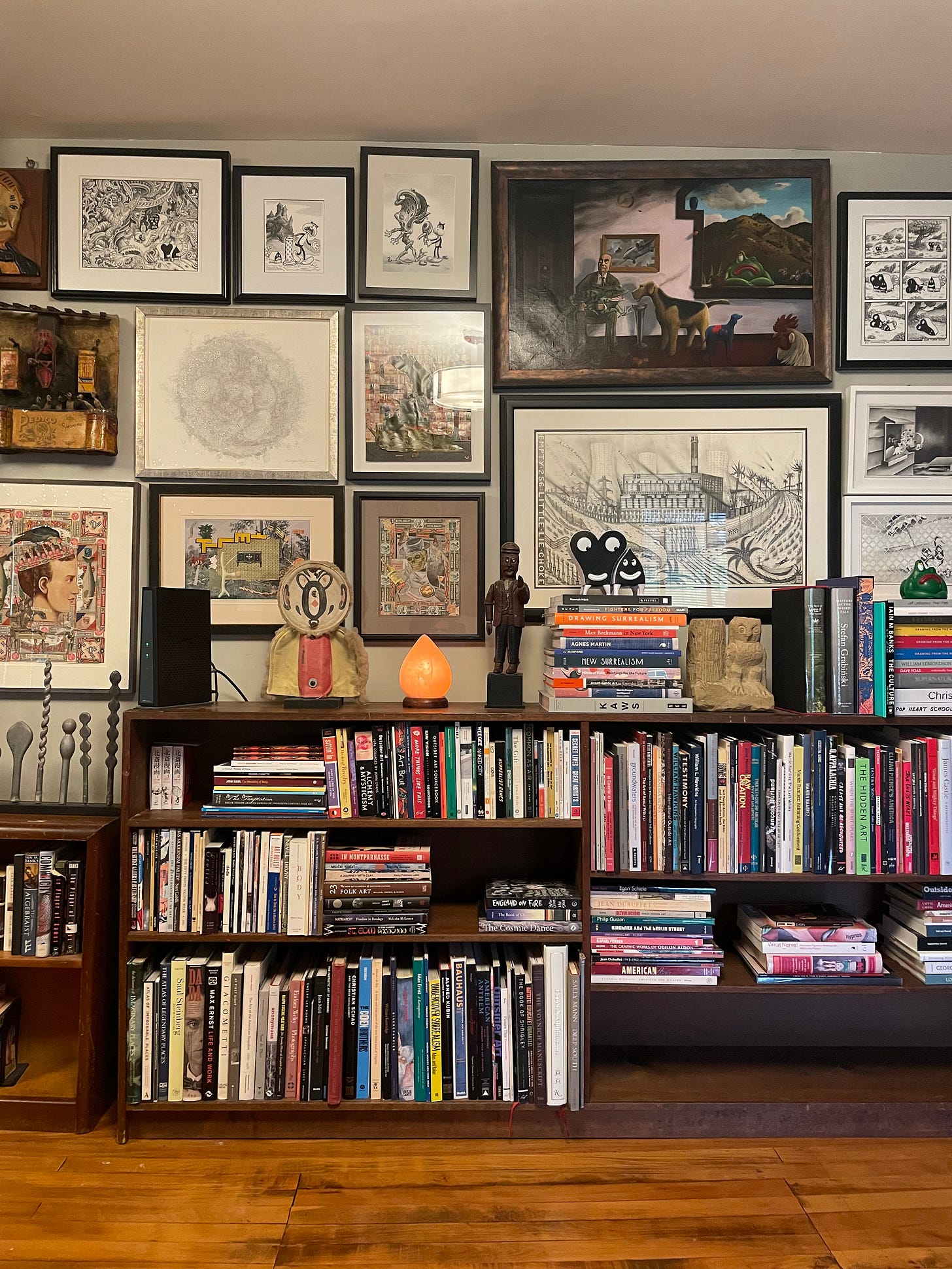
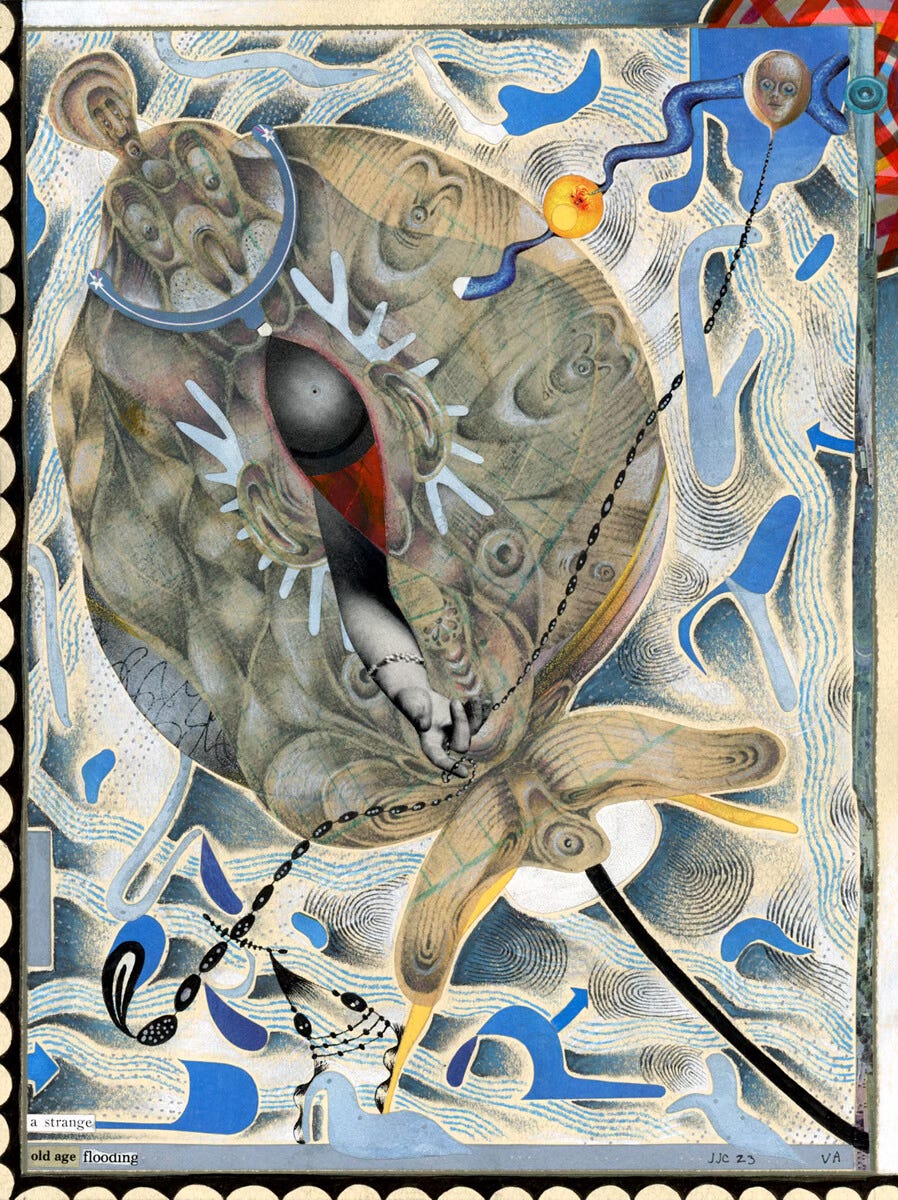
Ditto what Simon said below! A really intriguing and enjoyable discovery. Thank you for sharing this with us.
What a great discovery, I love. As I scrolled past the drawings and the cartoon cutouts, Jim Woodring sprang to mind, then i saw the collection!